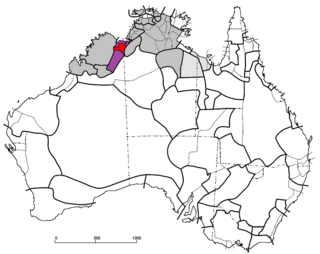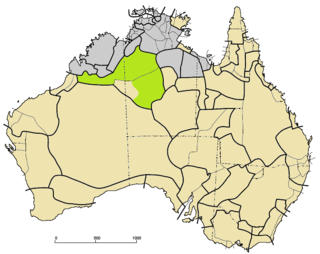
The Indigenous languages of Australia number in the hundreds, the precise number being quite uncertain, although there is a range of estimates from a minimum of around 250 up to possibly 363. The Indigenous languages of Australia comprise numerous language families and isolates, perhaps as many as 13, spoken by the Indigenous peoples of mainland Australia and a few nearby islands. The relationships between the language families are not clear at present although there are proposals to link some into larger groupings. Despite this uncertainty, the Indigenous Australian languages are collectively covered by the technical term "Australian languages", or the "Australian family".
The Laragiya language, also spelt Larrakia, and also known as Gulumirrgin, is an Australian Aboriginal language spoken by just six people near the city of Darwin in northern Australia as of 1983. Only 14 people claimed to know the Laragiya language in 2016.

Maningrida, also known as Burarran, is a small family of Australian Aboriginal languages spoken in northern Australia. It includes four languages, none closely related:

The Iwaidjan or Yiwaidjan languages are a small family of non-Pama–Nyungan Australian Aboriginal languages spoken in the Cobourg Peninsula region of Western Arnhem Land.

The Worrorran (Wororan) languages are a small family of Australian Aboriginal languages spoken in northern Western Australia.

The Bunuban languages are a small family of Australian Aboriginal languages spoken in northern Australia. The family consists of two languages, Bunuba and Gooniyandi, which are related to each other to about the same degree that English is related to Dutch. Bunuba has about 100 speakers and Gooniyandi about 400. Both are endangered.

The Wunambal language, also known as Northern Worrorran, Gambera or Gaambera, is a moribund Australian Aboriginal language of Western Australia. It has several dialects, including Yiiji, Gunin, Miwa, and Wilawila. It is spoken by the Wunambal people.
Doolboong is an extinct Australian Aboriginal language formerly spoken by the Doolboong on the coast of the Cambridge Gulf in the Northern Territory.
Gajirrawoong, also written Gajirrabeng, Gadjerawang, Gadjerong, Gadyerong and Kajirrawung, is an Australian Aboriginal language of the Kimberley region in Western Australia. It is at least endangered and possibly extinct; as of 2004 it was known by only three or four fluent speakers, and in the 2016 Australian Census, there were no recorded speakers using it at home. It is in the Jarrakan language family, and is the language of the Gajirrawoong people.

Miriwoong, also written Miriuwung and Miriwung, is an Aboriginal Australian language which today has fewer than 20 fluent speakers, most of whom live in or near Kununurra in Western Australia. All of the fluent speakers are elderly and the Miriwoong language is considered to be critically endangered. However, younger generations tend to be familiar with a lot of Miriwoong vocabulary which they use when speaking Kimberley Kriol or Aboriginal English, and there is active language revitalization.
Gija is an Australian Aboriginal language today spoken by about 200 people, most of whom live in the region from Halls Creek to Kununurra and west to Lansdowne and Tableland Stations in Western Australia. It is a member of the Jarragan language family, a non-Pama-Nyungan family in the East Kimberley. The Argyle Diamond Mine, on the south-western corner of Lake Argyle, is on the borders of Gija and Miriwoong country. The Purnululu National Park, which contains the Bungle Bunglee Range, is located mostly in Gija country.

Wardaman is an Australian Aboriginal language isolate. It is one of the northern non-Pama–Nyungan languages. Dagoman and Yangman were either dialects or closely related languages; as a family, these are called Yangmanic.
Ju Ju Wilson is an Aboriginal artist and part of the contemporary Indigenous Australian art movement.
Wadjiginy, also known as Wagaydy (Wogait) and Batjamalh, is an Australian Aboriginal language. Apart from being closely related to Kandjerramalh, it is not known to be related to any other language, though it has borrowed grammatical and lexical material from neighboring Northern Daly languages.
Mangarrayi is an Australian language spoken in the Northern Territory. Its classification is uncertain. Margaret Sharpe originally sought to record the language but turned to the study of Alawa after the station owner where her informants lived denied her access, having tired of the presence of researchers on the property.

Bunuba is an Australian Aboriginal language spoken by some 41 older Bunuba adults, most of whom live in Junjuwa, an Aboriginal community in Fitzroy Crossing in Western Australia. Bunuba is not related to the Pama-Nyungan language family that spans the majority of Australia; however, it is a relative of Guniyandi. Both are subgroups of the Bunuban language family. Bunuba consists of two dialects, 'light' and 'heavy' Bunuba.

The Ngumpin–Yapa a.k.a. Ngarrka–Ngumpin languages are a family of Pama–Nyungan languages of the Pilbara region of Australia.

The Marrngu languages are a branch of the Pama–Nyungan language family of Australia.

The Garawan languages (Garrwan), or Yanyi, are a small language family of Australian Aboriginal languages currently spoken in northern Australia.
The Mati Ke, also known as the Magatige, are an Aboriginal Australian people, whose traditional lands are located in the Wadeye area in the Northern Territory. Their language is in serious danger of extinction, but there is a language revival project under way to preserve it.











